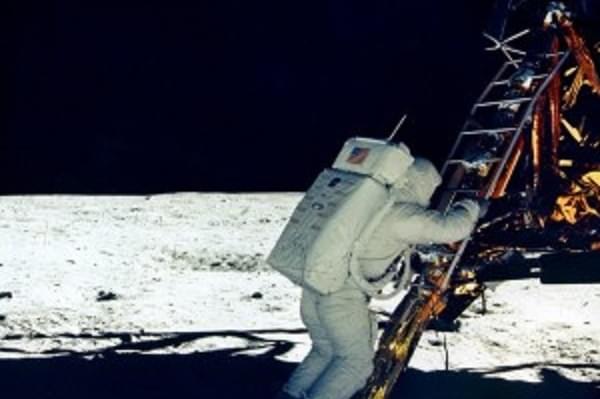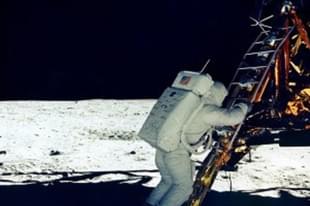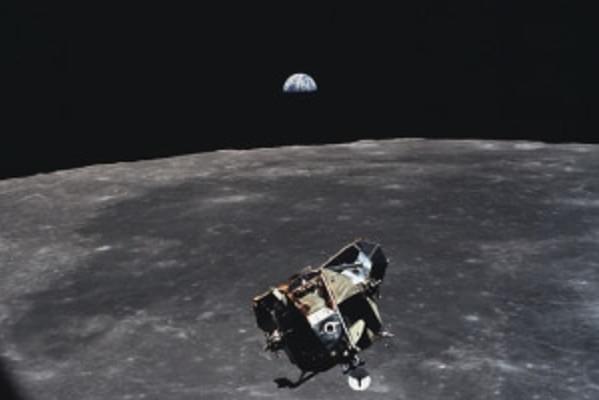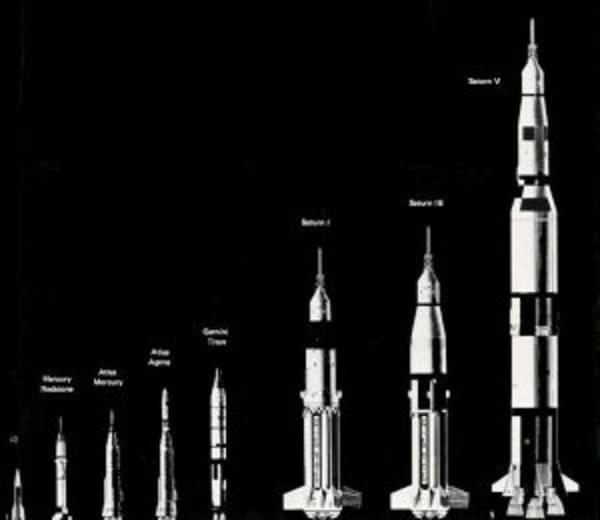Technology
The Greatest Technological Achievement Of The 20th Century – The Apollo 11 Mission To Moon To Soon Turn 50
Amit Paranjape
Jun 16, 2020, 09:48 AM | Updated 12:36 PM IST
Save & read from anywhere!
Bookmark stories for easy access on any device or the Swarajya app.


The Apollo Program, which reached its zenith with that memorable line from Neil Armstrong, was in my humble view – the greatest technological achievement of the 20th Century. 20 July, 1969, was not only NASA’s finest hour; it was mankind’s finest hour. If technology and technology-driven progress are the cornerstones of the past century, no other success represents it better!
On 20 July 2019, we celebrated the 50th anniversary of this historic event. It was an opportunity to pause and admire. It was an opportunity to wonder and think back in awe. It was an opportunity to understand. It was an opportunity to learn. As a student of science and technology, the Apollo Program fascinates me no end, even today.
In this blog, I will make an attempt to recollect the incredible facts and stories about this program. But numbers don’t tell the whole story. The sheer circumstances under which these successes were achieved are mind boggling and simple factoids won’t do justice.
How It All Began
It’s one thing to set impossible goals, and it’s another to actually achieve those…and achieve them, they did… With a year to spare!
It all started with that John F. Kennedy speech to the Congress in the 1961 (And followed by the famous ‘We choose to go the moon…’ speech at Rice University). Or maybe the moon race started a little before that – following the launch of Sputnik by the Soviet Union. Post World War II, America and Soviet Union entered into a massive space race, armed with some important spoils from Nazi Germany.
The German rocket program was quite extensive, and it had successfully built and deployed the V1 and V2 rockets. Much bigger plans were on the anvil, but the course of the war prevented them from being materialized. Apparently, in 1945 the Germans had devised designs for a rocket (specifically, a ballistic missile) that could reach the American shores.
The Russians captured the German rocket base at Peenemünde, but the lead scientist Wernher von Braun escaped and surrendered to the Americans, along with a small team of scientists. USSR used the infrastructure, design prototypes, drawings at Peenemünde to kick start their space program and scored the first win over U.S. with Sputnik.
Coming back to Von Braun, the reason why I am mentioning him here is because he went onto to become the lead for the massive Saturn series rockets program.
But Saturn V and Apollo 11 didn’t happen overnight. There were many other stepping stones, which started with America’s first space launch in 1958 of the satellite Explorer I…., first manned launch in 1961 (John Sheppard was the first to make a sub-orbital flight, and John Glenn (who later on went to become a senator, and also the oldest man to travel in space in the space shuttle in 1998, at the age of 77) did the first full orbit around the earth.…and through a series of Gemini series missions.
The Apollo program was conceived back in 1961 towards achieving Kennedy’s goal.
Before we take a look at the Apollo Program, let’s briefly understand the overall components of the Saturn V rocket and the Apollo spacecraft.
The Saturn V was a multi-stage (3 stage) rocket with the Apollo Spacecraft payload on the top. Some of the earlier Apollo missions were based on the Saturn 1B rocket, which essentially was a smaller version of the Saturn V. The Saturn V was designed to deliver the spacecraft payload consisting of: Command Module (Columbia), Service Module and Lunar Module (Eagle) – into the lunar orbit.
The first stage stood 138 ft tall and was powered by Kerosene and Liquid Oxygen. The first stage reached a height of nearly 45 miles, and achieved a speed of nearly 2 km/sec. The 2nd stage stood 81.7 ft tall and was powered by Liquid Hydrogen and Liquid Oxygen. The second stage reached a height of 110 miles, and achieved a speed of nearly 7 km/sec. The third stage stood 58.7 ft tall and was powered by Liquid Hydrogen and Liquid Oxygen. The third stage got the Apollo Spacecraft into an earth orbit. It was also fired again (to reach 11 km/sec – the escape velocity of earth) to push the Spacecraft out of the earth orbit, into a course towards the moon.
The Command Module, ‘Columbia’ orbited was the ‘mother ship’ of the Apollo Spacecraft. Armstrong and Aldrin transferred over to the Lunar Module ‘Eagle’, while Collins stayed in the lunar orbit. The Service Module was attached to the Command Module and contained support systems and propulsion systems for the return journey to the earth.
The Lunar Module, ‘Eagle’ descended towards the moon, with rocket thrusters to slowdown and control the approach.
From The Tragedy Of Apollo 1 To Great Success Of Apollo 10
The Apollo Program started with a disaster. Apollo 1 capsule caught fire during a test on the launch pad and the three astronauts burned to death. Amongst them was Edward White, the first American to do a Space-Walk. This was the first loss of life suffered by the American Space Program, and was a huge blow. It resulted in a lot of rethinking and introspection by NASA.
There were some major revisions in the plan, and the program went on. The earlier Apollo missions completed a series of tests of the different components and the sub-systems. These included the earlier generation Saturn 1 and Saturn 1B rockets, the Saturn V rocket, the Command Module, the Service Module and the Lunar Module (NOTE – I will not go into details of the complete design…readers who are interested can…).
The initial series of launches (Apollo 2 – Apollo 6) were unmanned missions.
Apollo 7 lifted off on 11 October 1967 and was a confidence building mission. The 3 man crew went into a low earth orbit and tested various systems of the lunar and the command modules. Testing of the maneuverability of the Lunar Module in the weightlessness of space was very important.
Apollo 8 was the first flight to head to the vicinity of the moon. It was also the first manned flight of the awe-inspiring Saturn V rocket. The crew of Apollo 8 included command module pilot Jim Lowell, who was later the commander of the ill-fated Apollo 13. Apollo 8 provided the first views of the other side of the moon.
Apollo 9 carried out first lunar orbit and manned testing of the lunar module Apollo 10 carried out the lunar module descent to within 50,000 feet from the surface of the moon. The stage was now set for Apollo 11.
Apollo 11 – ‘The Eagle Has Landed’
Apollo 11 blasted off in space on 16 July 1969. After four days, on 20 July 1969, the Lunar Module started its descent onto the surface of the moon.
‘Houston, Tranquility Base here. The Eagle Has Landed’. Land successfully, it did! But it was over 4 km off-course. It was running low on fuel and had only 30 sec of spare fuel left to land.
It took Armstrong and Aldrin a few hours to check and secure all the systems, until Armstrong could set foot on the moon.
The Apollo 11 astronauts setup various instruments and the American flag on the moon. Various lunar rock samples were collected. Future Apollo missions also carried a motorized rover that could take the astronauts over a longer distance to explore the moon surface.

During liftoff, the landing stage of the Eagle (with its empty fuel tank) was left on the moon, to save weight. The ascent engine powered Eagle back into the lunar orbit and docked it back again with the command module. Armstrong and Aldrin got back into the Command Module, and then jettisoned the lunar module. The Command-Service Module (CSM) then fired its return engine to set them back on a trajectory towards earth.
On 24 July, the Command Module Capsule splashed down in the Pacific mission to mark the completion of this most historic mission.
Why Was It Such A Great Achievement?
As I write this, I look at the progress that has happened in the space program since the last Apollo nearly 40 years ago. Just this past week, NASA was struggling to launch the Space Shuttle in midst of some weather problems. Agreed that there were major budget cuts in the American Space Program post Apollo, but still the achievements of the past 4 decades leave a lot to desire, in comparison to the Gold Standards set in the 1960s. Note – I am not taking anything away from the 100 + Space Shuttle missions and International Space Station.
Can you imagine running the entire Apollo 11 flight computer on something less powerful than your cell phone’s chip? Well, ran they did! Today, the gadgets all around us are equipped with microprocessors – from a music system, to a washing machine. From a camera, to a car. But remember, Intel’s first microprocessor, the 4 bit 4004 didn’t make its debut until 1971! So just think of this – such a complex space mission was executed with electronic components that was less powerful than your microwave oven!
Think of the gargantuan Saturn V rocket that moved from concept to design to manufacture to successful prototyping and execution, in under a decade! The first American and Soviet rockets that went into space in the late 1950s were tiny (barely 50 ft, with a capacity to put a 50 kg satellite in earth orbit) and extremely unsophisticated compared to the Saturn V (standing 363 ft tall, could put payloads in excess of 100 Tons in earth orbit) that first flew in 1968.

Realize that a rocket is a very a complex system and contains hundreds of sub-systems and millions of parts. There’s propulsion, guidance, communication, telemetry, navigation – just to name a few major ones. And there are backups…backups for almost every system. And backups for backups!
Let’s take a few examples. Telemetry deals with streaming hundreds of data parameters from the spacecraft back to Mission Control in Houston, 200,000 miles away. This data had to be interpreted, analysed (through a combination of automated and manual processes) and acted on, round-the-clock.
The propulsion system of the rocket engines provides the necessary thrust. The Saturn V’s first stage had 5 F1 Engines generating the kind of power, most probably not generated in any machine since then! I will not bore you with many numbers, but here’s a simple comparison. The main engines of Saturn V generated enough power, equivalent to about 150 Giga Watts. That is about the entire installed electric power generation capacity of India!
Or about 2.5 times the power generated in Texas, USA. Or about 80 times the power generated by one of the largest hydro-electric plants in North America – The Hoover Dam. Just the fuel pumps of these engines consumed power equivalent to that needed by the City of Pune!
To get a sense of the complexity of internals of the command module and the lunar modules, I would just recommend watching that Hollywood classic – Apollo 13 (Which incidentally happens to be my most favourite movie). A typical automobile has a few thousand parts. The Apollo command, service and lunar modules had over a million.
Navigation and Guidance are extremely challenging tasks for any space mission. Extremely small errors can take the rocket on a wrong trajectory which could mean completely missing the target (The Moon) or come crashing down and burn up in the Earth’s atmosphere on the return.
I will go back to the Apollo 13 mission for a minute. Sometimes failures highlight the successes of a project more than anything else. Imagine doing near real-time analysis, diagnosis, generating remote workarounds and implementing repair 200,000 miles in space! But the Apollo Program was designed to handle these scenarios. Coming back to Apollo 13, one NASA personnel put it quite nicely – ‘It (Apollo 13) was NASA’s most successful failure!’
And I haven’t discussed the manufacturing and assembly challenges at all. Building a 3000 Ton machine is no easy job. Building one that will fly at speeds of 2 km/sec is another. Note – the final stage of Saturn V, which powered the Apollo Spacecraft towards the moon, did eventually approach the earth escape velocity of 11 km /sec.
Massive fuel tanks had to be designed that could withstand extreme pressures and temperatures, and fabricated in pieces and then assembled. Just to highlight one example here, consider the scale of the fuel consumption of the Saturn V main engines. To generate the kind of power mentioned earlier, you need lot of fuel!
The first stage of Saturn V consumed Kerosene (as the propellant) and Liquid Oxygen. It gobbled up around 15 Tons of Kerosene/sec! Just think of the complex high-power pumps and piping needed to feed this kind of fuel into the engines, to generate that massive power!
The Lunar Module was the most complex of the machines and was assembled in a special plant. Specialized Heat Shields that can withstand temperatures over 3000 F on reentry had to be tested and built.
Lastly, I would like to highlight the program management aspects of this effort. We routinely see major engineering projects dragging for years. Here was a project of this startling magnitude, moving from conception to execution stage in less than 10 years!
There were so many historic firsts in this project…in the areas of size, scale, complexity and ingenuity. But ultimately these facts don’t tell the whole story. I guess the ultimate greatness of Apollo 11 was how it captivated an entire generation!
Also by the author: 10 Fascinating Factoids About The Apollo Program’s Saturn V Rocket
A Technology Entrepreneur, with many diverse interests across Information Technology, Emerging Tech, Economics, Healthcare, History, and Urban Development. He tweets @aparanjape





